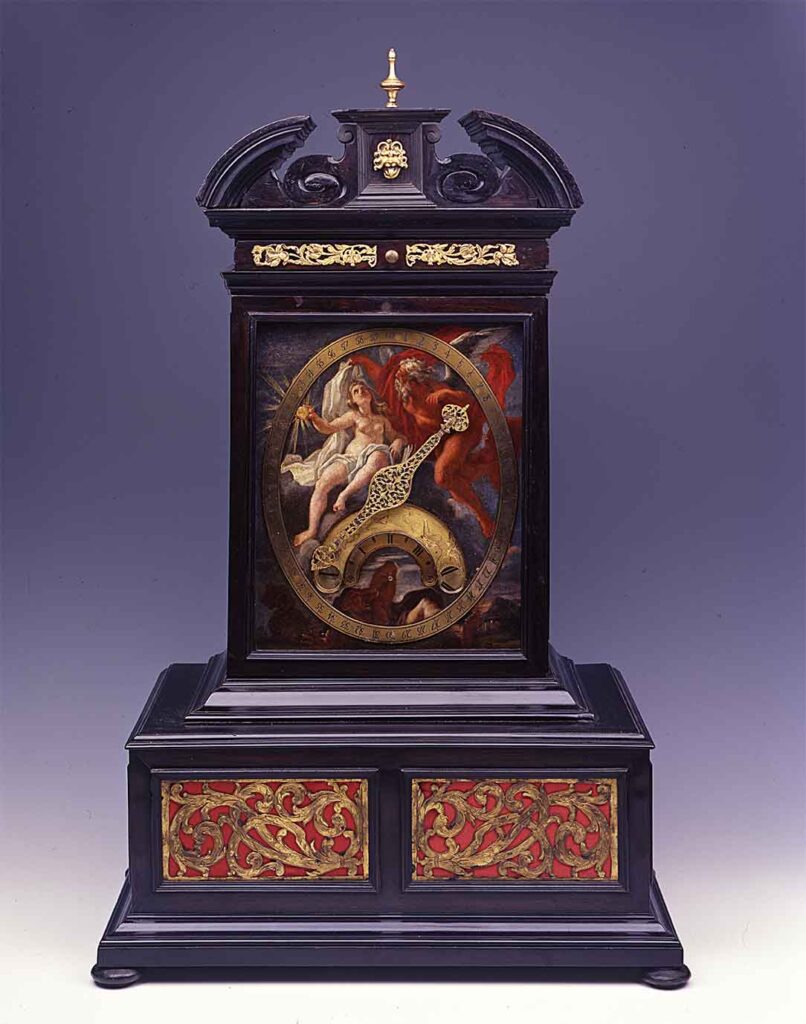Altar Clock with Carillon
Giovanni Pietro Callin , 1660 - 1670
Description

This ‘altar’ clock, inspired by the shape of Counter Reformation altarpieces, recalls ‘night’ clocks both in the architectural structure of its ebonised wood case and in its face, where the discs showing the hours revolve in a semicircular opening. The practice of painting the face, typical of Italian clocks, began only between 1660 and 1670.
The allegorical subject portrayed here is frequent in ‘night’ clocks. Truth, the friend of light, is holding the Sun in her right hand and wearing a minimum of drapes, since it is in her nature to be simple. Time is depicted as an old winged man, like the saying, volat irreparabile tempus (time flies). Falsehood, with his brown flesh almost lost in the darkness of the background, lies twisted at their feet.
Two inscriptions alluding to the transience of time appear on the semicircle of the hours. Originally from Genoa, Baciccio moved to Rome when young where, thanks to his friendship with Bernini, he became successful with both the lay and the ecclesiastical aristocracy. Realised in about 1670, this work is held to be one of the first commissioned from the artist, due to a certain awkwardness in rendering the volumes and the perspective.
Data Sheet
Author
Giovanni Pietro Callin
Date
1660 - 1670
Material and technique
Ebonized wood, gilt bronze; brass (oil painting);
Measures
730 mm x 465 mmx 290 mm
Acquisition
Bruno Falck donation, 1973
Inventory number
3430
location
Clock Room
One of Italy’s most important collections of antique watches is housed here. The room was inaugurated in 1973 and completely refurbished in 2015 with the addition of a multimedia station that shows the watches in motion, allows visitors to listen to their sounds, and admire their hidden faces. In addition to the few but very notable pieces acquired by Gian Giacomo, in 1973 the substantial donation of Bruno Falck, a steel magnate, was added, offering the Museum one hundred and twenty-nine extraordinary examples of mechanical clocks, in 1978 the collection of sundials by Piero Portaluppi (now displayed in the Palma Room), and in 2017 the former collection of Luigi Delle Piane (displayed in the Hall of Person Clocks). The collection allows one to travel through the history of European luxury watchmaking from the 16th to the 19th century.
collection
Clocks and watches
About 500 pieces form the most important antique horology collection in Italy. It was enriched thanks to donations, as the ones by Bruno Falck, Luigi Delle Piane, Alfredo Zanotelli, Angelo Reina. The collection illustrates the history of European clockmaking from the 16th to the 19th century. It includes Renaissance and Baroque table clocks as well as German, English, French and Swiss ones. Extraordinary items not only for their mechanisms but also for their precious case’s decorations.
